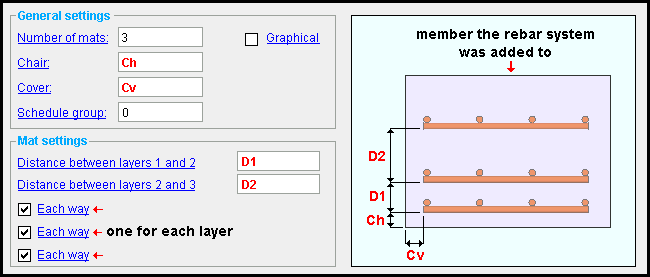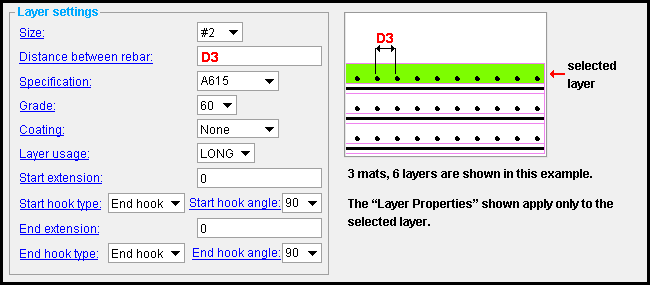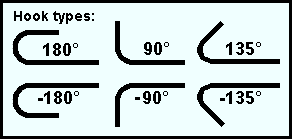 Add Rebar Area Layout ( Modeling )
Add Rebar Area Layout ( Modeling )


|
|
Also see :
|
- Modeling (where custom components can be added)
- Modify Rebar Hooks (can add rebar hooks to rebar area layouts)
- Custom components (topic)
- Copy Component (to copy the component to another concrete slab, wall, or footing)
- Move Component (to move the component to another concrete beam, column, or pilaster)
- Explode Component (to reduce the component to its constituent materials and welds)
- Component Selection Tool (to search for custom components of a selected type)
- Model Tree (to find custom components and select them for deletion, editing, etc.)
concrete | model > component > | add component | top
 To add the rebar area layout custom component :
To add the rebar area layout custom component :
A Rebar Area Layout custom component can be added to concrete slabs , concrete walls , elevation walls , CMU walls and pad footings . A rebar area layout becomes a component of the member to which it was added.
1 . In Modeling , use Snap to Surface or a similar tool to go to the surface of an appropriate member to which you want to add the rebar area layout.
2 . Move your current view into the screen to the bottom of the concrete member; that is, to the face of the concrete member that was furthest into the screen when you snapped to the surface of the member. To do this, choose View > Relative Depth and enter a negative depth (-) that is equal to the thickness of the slab, footing, or wall.
3 . Select the concrete member. It changes to the " Primary selection color " (green).
4 . Choose Model > Component > Add .
5 . On the custom component selection list, choose " Rebar Area Layout " as the custom component you want to add.
Tip: If you use in-tool selection -- that is, select the member after selecting " Rebar Area Layout " as the custom component you want to add -- only concrete and CMU walls, elevations walls, concrete slabs, and pad footings will be selectable. 6 . The status line prompts, " Locate Point. " Locate- Pan -Return mouse bindings become active. Do the following:


bindings 6a : Select the appropriate Locate option, then left-click ( Locate ) to place work points clockwise around the perimeter of the desired location for the rebar area layout.
6b : Middle-click ( OK ) with your mouse pointer anywhere in the view. This locates the final point exactly where you placed the starting point.
7 . Locate a reference point for the rebar system.
8 . Locate a direction point. The angle of the line between the reference point you located previously and the point you select will determine the direction of the rebar grid(s).
9 . The Rebar Area Layout Edit window opens. Enter the settings that you want, then press " OK " to close the window.
10 . If User and Site Options > Modeling > " Automatically process after modeling operation " is set to ' Process and create solids ', the bars will be generated immediately. If not, the bars will be generated in the member the next time the member undergoes Process and Create Solids .
concrete | model > component > | add component | top
 To delete or edit the Rebar Area Layout custom component :
To delete or edit the Rebar Area Layout custom component :
To delete a Rebar Area Layout custom component: 1 ) Use the Component Selection Tool and select the component in the slab, footing, or wall. Or, select the component in the Model Tree . 2 ) Press the Delete key (or choose Edit > Delete ). 3 ) Process and Create Solids , if User and Site Options > Modeling > " Automatically process after modeling operation " is not set to a choice that makes create solids take place automatically.
To edit a Rebar Area Layout custom component or review its settings, you can find the member it is added to and open its edit window. The component's settings will be contained in that window in a section named [ Rebar System ] . To edit a Rebar Area Layout custom component without opening a member edit window, use the Model Tree . You also can use the Selection Filter toolbar item to select the ' Custom Components ' filter and double-click any bar in the rebar area layout to edit the tie layout. The Component Selection Tool can also be used to edit (and find) custom components.
concrete | model > component > | add component | top
 Rebar Area Layout custom component settings:
Rebar Area Layout custom component settings:
------  General settings ------
General settings ------
|
A Rebar System component is automatically set to "
Graphical " whenever you make graphical changes to any of its bars. For example, when you Edit Material or apply the Extend Rebar Ends tool on one of the bars. This stops the component from being changed during Process and Create Solids . Click here for more information.
Instead of allowing the component to be made "
Graphical ," you may wish to Explode Component .
Schedule group: Any non-negative integer with less than ten digits. Your choice of schedule group is not limited by any configuration option. The group applies to this member only -- see special case below.
Reason to assign a schedule group: The output of the Rebar List Report , Rebar in Member Report , and Bend Schedule custom reports can be limited to particular schedule groups. As a result, you can assign rebar shape material to different schedules, and create separate reports for rebar from each schedule.
A special case: You change the schedule group on one of the rebar shapes. If you press " Yes " when prompted " Do you want regenerate... ," the changed schedule group is applied to ALL rebar matching the options checked in the Change All Options window.
User configuration: You can open the Report Manager window or the Table Edit window to copy, create, or edit rebar custom reports. " Edit " the report to add a comma-delimited list of schedule groups that the custom report will select.
Number of mats: The number of grids. Each grid consists of a main bar layer, and -- when " Each way " is checked -- a secondary bar layer.
Chair: The distance (in the primary dimension " Units " or other units ) between the workplane that you were in when you added the component and the furthest layer of the furthest mat relative to your current view, if you added your workpoints clockwise. If you added your workpoints counterclockwise, this will be the distance between the workplane and the nearest layer of the nearest mat.
Cover: The distance (in the primary dimension " Units " or other units ) from the ends of the rebar to the edges of the concrete member.
------  Mat settings ------
Mat settings ------
Distance between mats 1 and 2: The on center distance (in the primary dimension " Units " or other units ) between mats. This applies the " Number of mats " is greaer than one, and another " Distance between mats ..." option is added for each mat. (For example, " ...between mats 2 and 3 ," " ...between mats 3 and 4 ," etc.)
If ' Each way ' is checked (
), the mat consists of a grid of two perpindicular layers of parallel bars.
If ' Each way ' is not checked (
), the mat is a single layer of parallel reinforcing bars.
------  Layer settings ------
Layer settings ------
Size: A size designation that has been entered to the Rebar Definitions Setup window under the " Active rebar standard ".
Distance between rebar: The on center distance (in the primary dimension " Units " or other units ) between rebar of that layer.
Specification: A615 or A706 or etc. This is an ASTM specification entered into the Rebar Specifications window.
Grade: 60 or 40 or etc. This is the yield strength (grade) of the rebar.
The grade choices in this list box are limited to those entered in the Rebar Specification window for the " Specification " chosen for this rebar.
Coating: None or a Coating designation that is available in the " Standard " that you have selected.
The coating choices in this list box are limited to those entered in the Rebar Specification window for the " Specification " chosen for this rebar shape.
Select ' None ' if you do not want a coating. Since it is possible to create specifications that do not have coatings, it is possible that ' None ' may be your only option.
User configuration: If a coating is not available for selection, selecting a different " Specification " will make that coating available if the coating you want is in that other standard. If you don't want to change to a different " Specification ," you can open the Rebar Specifications window and add the coating you want to the specification that you currently have selected.
Layer usage: Blank or a usage description . The " Layer usage " that you enter here is used on the schedules that appear on drawings.
The usage descriptions in this field are limited to those entered in the Rebar Usage Descriptions window for the member category (e.g., ' Wall ', ' Pad Footing / Slab ', etc.) on which this component is placed.
User configuration: To add a " Layer usage " that you can select here, type the function to a blank line in the member category (e.g., ' Wall ', ' Pad Footing / Slab ', etc.) of the Rebar Usage Descriptions window.
Start extension: The distance (in the primary dimension " Units " or other units ) that the start (i.e., the left end) of the rebar extends beyond the " Cover ."
Start hook type: None or End hook or Stirrup hook or Seismic stirrup hook . This is the type of hook, if any, that appears at the left end of the rebar shape material. The " Hook type " chosen here determines which choices are available for the " Start hook angle " setting.
|
Hook
type |
Available angles |
| None | — |
| End hook | 90, 180, -90, -180 |
| Stirrup hook | 90, 135, -90, -135 |
|
Seismic
stirrup hook |
135, -135 |
Start hook angle: None or 180 or 135 or 90 or -90 or -135 or -180 . This is the bend, if any, that appears at the left end of the rebar shape material. The entires available here are determined by the entry made to " Start hook type ". The only value available for seismic stirrups is (±) 135 .

End extension: The distance (in the primary dimension " Units " or other units ) that the right end of the rebar extends beyond the " Cover ."
End hook type: None or End hook or Stirrup Hook or Seismic Hook . This is the type of hook, if any, that appears at the right end of the rebar shape material. The " End hook type " chosen here determines which choices are available for the " End hook angle " setting.
|
Hook
type |
Available angles |
| None | — |
| End hook | 90, 180, -90, -180 |
| Stirrup hook | 90, 135, -90, -135 |
|
Seismic
stirrup hook |
135, -135 |
End hook angle: None or 180 or 135 or 90 or -90 or -135 or -180 . This is the bend, if any, that appears at the right end of the rebar shape material. The entries available here are determined by the entry chosen for " End hook type ". The only entry available for seismic stirrups is (±) 135 .








